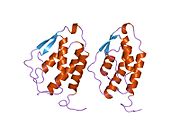- Granulocyte macrophage colony-stimulating factor
-
Not to be confused with granulocyte colony-stimulating factor.
Granulocyte-macrophage colony-stimulating factor 
three-dimensional structure of recombinant human granulocyte-macrophage colony-stimulating factor Identifiers Symbol GM_CSF Pfam PF01109 Pfam clan CL0053 InterPro IPR000773 PROSITE PDOC00584 SCOP 2gmf Available protein structures: Pfam structures PDB RCSB PDB; PDBe PDBsum structure summary Granulocyte macrophage colony-stimulating factor 
Systematic (IUPAC) name Human granulocyte macrophage colony stimulating factor Clinical data Pregnancy cat. ? Legal status ? Identifiers CAS number 83869-56-1 ATC code L03AA09 DrugBank BTD00035 Chemical data Formula C639H1006N168O196S8 Mol. mass 14434.5 g/mol Granulocyte-macrophage colony-stimulating factor, often abbreviated to GM-CSF, is a protein secreted by macrophages, T cells, mast cells, endothelial cells, and fibroblasts.
Contents
Functions
GM-CSF is a cytokine that functions as a white blood cell growth factor. GM-CSF stimulates stem cells to produce granulocytes (neutrophils, eosinophils, and basophils) and monocytes. Monocytes exit the circulation and migrate into tissue, whereupon they mature into macrophages and dendritic cells. Thus, it is part of the immune/inflammatory cascade, by which activation of a small number of macrophages can rapidly lead to an increase in their numbers, a process crucial for fighting infection. The active form of the protein is found extracellularly as a homodimer.
Genetics
The human gene has been localized to a cluster of related genes at chromosome region 5q31, which is known to be associated with interstitial deletions in the 5q- syndrome and acute myelogenous leukemia. Genes in the cluster include those encoding interleukins 4, 5, and 13.[1]
Glycosylation
Human granulocyte macrophage colony-stimulating factor is glycosylated in its mature form.
Clinical significance
GM-CSF is also known as molgramostim or, when the protein is expressed in yeast cells, sargramostim (Leukine).
GM-CSF is used as a medication to stimulate the production of white blood cells following chemotherapy.
GM-CSF has also recently been evaluated in clinical trials for its potential as a vaccine adjuvant in HIV-infected patients. The preliminary results have been promising[2] but GM-CSF is not presently FDA-approved for this purpose.
Leukine
Leukine is the trade name of sargramostim, recombinant yeast-derived GM-CSF developed at Immunex (now Amgen) and first given to six humans in 1987 as part of a compassionate-use protocol for the victims of the Goiânia cesium irradiation accident.[3] It is currently manufactured by Berlex Laboratories, a subsidiary of Schering AG. Its use was approved by U.S. Food and Drug Administration for acceleration of white blood cell recovery following autologous bone marrow transplantation in patients with non-Hodgkin's lymphoma, acute lymphocytic leukemia, or Hodgkin's disease in March 1991.[3] In November 1996, the FDA also approved sargramostim for treatment of fungal infections and replenishment of white blood cells following chemotherapy.[4]
Controversy
Berlex funded a study that ran in the May 26, 2005 issue of the New England Journal of Medicine, which concluded that GM-CSF did produce significantly more remissions in Crohn's disease than those having received a placebo in the study, and it also decreased disease severity and improved quality of life.[5]
The study's lead author, Joshua Korzenik of Harvard Medical School and Massachusetts General Hospital, is a paid consultant for Berlex , and co-inventor of the patent, which is owned by Washington University.[6]
Rheumatoid arthritis
GM-CSF is found in high levels in joints with rheumatoid arthritis and blocking GM-CSF may reduce the inflammation or damage. Some drugs (eg MOR103) are being developed to block GM-CSF.[7]
See also
References
- ^ "Entrez Gene: CSF2 colony stimulating factor 2 (granulocyte-macrophage)". http://www.ncbi.nlm.nih.gov/sites/entrez?Db=gene&Cmd=ShowDetailView&TermToSearch=1437.
- ^ Breitbach CJ, et al. (2011). "Intravenous delivery of a multi-mechanistic cancer-targeted oncolytic poxvirus in humans". Nature 477 (7362): 99–102. doi:10.1038/nature10358. PMID 21886163.
- ^ "Approval Summary for sargramostim". Oncology Tools. U.S. Food and Drug Administration, Center for Drug Evaluation and Research. 5 March 1991. Archived from the original on 29 September 2007. http://web.archive.org/web/20070624223312/www.accessdata.fda.gov/scripts/cder/onctools/summary.cfm?ID=353. Retrieved 20 September 2009.
- ^ "Newly Approved Drug Therapies (179): Leukine (sargramostim), Immunex". CenterWatch. http://www.centerwatch.com/patient/drugs/dru179.html. Retrieved 12 October 2008.
- ^ Korzenik J, Dieckgraefe B, Valentine J, Hausman D, Gilbert M (2005). "Sargramostim for active Crohn's disease". N Engl J Med 352 (21): 2193–201. doi:10.1056/NEJMoa041109. PMID 15917384.
- ^ Bernstein DS (2006-04-12). "Med school drug pushers: How scientists are selling out to drug companies". The Boston Phoenix. http://www.thephoenix.com/Article.aspx?id=8920&page=1. Retrieved 2008-10-12.
- ^ "MOR103 - Antibody for the Treatment of Rheumatoid Arthritis, Germany". 2010. http://www.drugdevelopment-technology.com/projects/mor103/.
Further reading
- Esnault S, Malter JS (2002). "GM-CSF regulation in eosinophils". Arch. Immunol. Ther. Exp. (Warsz.) 50 (2): 121–30. PMID 12022701.
- Martinez-Moczygemba M, Huston DP (2003). "Biology of common beta receptor-signaling cytokines: IL-3, IL-5, and GM-CSF". J. Allergy Clin. Immunol. 112 (4): 653–65; quiz 666. doi:10.1016/j.jaci.2003.08.015. PMID 14564341.
- Mroczko B, Szmitkowski M (2005). "Hematopoietic cytokines as tumor markers". Clin. Chem. Lab. Med. 42 (12): 1347–54. doi:10.1515/CCLM.2004.253. PMID 15576295.
- Hamilton JA, Anderson GP (2005). "GM-CSF Biology". Growth Factors 22 (4): 225–31. doi:10.1080/08977190412331279881. PMID 15621725.
- Tortorella C, Simone O, Piazzolla G et al. (2007). "Age-related impairment of GM-CSF-induced signalling in neutrophils: role of SHP-1 and SOCS proteins". Ageing Res. Rev. 6 (2): 81–93. doi:10.1016/j.arr.2006.10.001. PMID 17142110.
- Robertson SA (2007). "GM-CSF regulation of embryo development and pregnancy". Cytokine Growth Factor Rev. 18 (3–4): 287–98. doi:10.1016/j.cytogfr.2007.04.008. PMID 17512774.
- Morales JK, Kmieciak M, Knutson KL, Bear HD, Manjili MH (2009). "GM-CSF is one of the main breast tumor-derived soluble factors involved in the differentiation of CD11b−Gr1− bone marrow progenitor cells into myeloid-derived suppressor cells". Breast Cancer Res Treat. 123 (1): 39–49. doi:10.1007/s10549-009-0622-8. PMC 3095485. PMID 19898981. http://www.pubmedcentral.nih.gov/articlerender.fcgi?tool=pmcentrez&artid=3095485.
PDB gallery External links
- http://www.gm-csf.com/ - Official gentaur web site
- http://www.leukine.com/ - Official Leukine web site
- MeSH Granulocyte-Macrophage+Colony-Stimulating+Factor
CFU-GEMM CFU-GM Granulocyte macrophage colony-stimulating factor: Granulocyte colony-stimulating factor - Macrophage colony-stimulating factorCFU-E CFU-Meg Categories:- Human proteins
- Cytokines
- Hematology
- Growth factors
Wikimedia Foundation. 2010.




